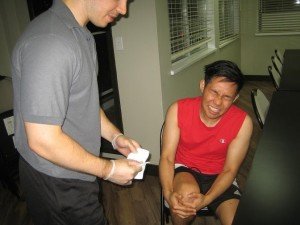Jumper’s knee usually results from the repetitive eccentric contraction of the quadriceps muscles that occurs particularly when an athlete jumps. As opposed to running wherein the peak contraction of the muscle is not that high, the maximal contraction of the muscle fibers when jumping puts a lot of stress on the tendon. Repetitive inflammation causes microruptures in the tendon which can eventually lead to a complete tear. This tear can occur anywhere along the length of the patellar tendon but is more common on the origin of the tendon inside the patella.
The Patellar tendon is a connective tissue that holds the patella, or the knee cap, in place by connecting to the quadriceps muscles superiorly and the tibia, or shin bone, inferiorly. Its primary role is to allow the knee joint, with the help of other muscles in the thigh area, to extend enabling the athlete to jump, kick and run. An injury to this tendon may, thus, affect the mobility and vertical leap of an athlete.
Signs and Symptoms of Jumper’s Knee
Signs and symptoms of Jumper’s knee is most often experienced by athletes but can also be present in people even if they do not engage in sports that involve a lot of jumping. Typical symptoms are as follows:
- Anterior knee pain is the first presenting symptom. The pain involvement is usually infrapatellar, or below the patella, but may also be suprapatellar.
- The pain may be present only during physical activity but may also persist even after. When the pain persists, it may interfere with the performance of the athlete or even daily movements.
- Tenderness is felt upon palpation of the inferior aspect of the patella, the superior aspect of the patella, or the tibial tuberosity, which is a bony protrusion at the top of the tibia.
- Hamstring and quadriceps tightness may also be experienced.
Since only the patellar tendon is involved, stability of the knee is often intact with a normal knee range of motion.
Staging of Jumper’s Knee

Knee pain experienced with a Jumper’s knee is used to classify the stage or the extent of the injured patellar tendon. The staging of Jumper’s Knee is as follows:
- Stage 1: Pain is felt only after activity. There is no functional impairment
- Stage 2: Paint is felt during and after activity. Function is minimally impaired.
- Stage 3: There is prolonged pain felt during and after the activity. There is increasing difficulty in performing at a satisfactory level.
- Stage 4: There is complete tendon tear that requires surgical repair
Treatment for Jumper’s Knee
Treatment for Jumper’s Knee may range from non-surgical to surgical depending on the staging of the injury.
For stage 1 and 2, the treatment options available are as follows:
- Immediately perform RICE (raise-ice-compress-elevate) to decrease pain and swelling. Enroll in First Aid Courses to learn how to perform RICE properly on injured individuals
- Pain relievers such as ibuprofen may provide short term relief
- The use of a counterforce strap, or a patellar tendon strap, may decrease the peak pressure at the moment of jumping by spreading the force to a wider area
- Stretching before and after a workout
- Leg strengthening exercises to balance the strain that the muscle exert on the patellar tendon
- Adequate rest
For stage 3, wherein pain is sustained and performance of an athlete is severely affected, therapeutic measures mentioned above should be continued. Complete avoidance of any activity that will trigger the pain is also recommended along with extended periods of rest that ranges from weeks to months. If pain is still persistent, more invasive procedures such as corticosteroid injections and platelet rich plasma injection may be recommended. Surgery is the last option apart from abandoning participation in jumping sports.
For stage 4, wherein there is a complete tear in the patellar tendon, surgical repair of the patellar tendon or the quadriceps tendon is the best available treatment.
Patellar tendonitis, or more commonly known as Jumper’s Knee, is a common overuse injury that is often seen in athletes that engages in sports that involve frequent jumping such as Basketball, Volleyball and Badminton.
https://www.youtube.com/watch?v=EbgnAuJGApQ
